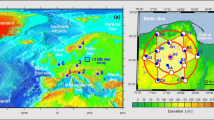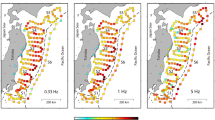Abstract
The main cause for mid-period seismic ground distortions are ocean waves generated by atmospheric disturbances. These act upon the earth through different mechanisms. The microseismic wavefield can be divided into primary (T =12–18 s) and secondary (T = 6–9 s) noise. Classical theory tells that the origin of these induced ground distortions depends on the location and the intensity of the low pressure region. A considerable part of the microseismic wave field reaches the GRF-array in southern Germany with high coherency and almost constant amplitudes. Thus it is possible to locate the generating areas using frequency-wavenumber analysis. Five discrete generating areas for secondary microseisms and three generating areas for primary microseisms could be determined in the Atlantic Ocean, the Arctic Sea and the Mediterranean Sea by investigating broadband continuous recordings over four months in winter 1995/96. An essential result is the long-time constancy of the backazimuths of the coherent part of the microseismic wavefield with respect to the origin areas, independent of the location of the moving low pressure zone. Results from a triangulation using additionally broadband data from the NORSAR-array and an independent estimation of the distance of the source region with water wave dispersion data indicate an origin of the secondary microseismic wavefield near the north-Norwegian coast for the strongest source. The array analysis of a temporary network of ten three-component broadband stations in south-east Germany shows that the ratio of energy between coherent Love and Rayleigh waves is much higher for the primary than for the secondary microseismic noise wavefield. This indicates differences in the source mechanisms.
Similar content being viewed by others
References
Båth, M. & O. Kulhánek, 1990. Longperiod microseisms at UmeÂ, Sweden. Phys. Earth Planet. Int. 63: 232–233.
Benjamin, T. B. & F. Ursell, 1954. The stability of the plane free surface of a liquid in vertical periodic motion. Proc. r. Soc. Lond. A 255: 505–515.
Ben-Menahem, A. & Sarva Jit Singh, 1981. Seismic waves and sources, Chapter 9.3: Gravity waves in liquids. Springer Verlag, New York: 776–796.
Bungum, H., E. Rygg & L. Bruland, 1971. Short period seismic noise structure at the Norwegian seismic array. Bull. Seism. Soc. Am. 61, No. 2: 357–373.
Bungum, H., S. Mykkeltveit & T. Kværna, 1985. Seismic Noise in Fennoscandia, with emphasis on high frequencies. Bull. Seism. Soc. Am. 75, No. 6: 1489–1513.
Capon, J., 1972. Long-period signal processing Results for LASA, NORSAR and ALPA. Geophysic Journal Roy. astronomical Soc. 31: 279–296.
Cessaro, R. K. & W.W. Chan, 1989. Wide angle triangulation array study of simultaneous primary microseism sources. J. geophys. Res. 94, No. B11: 15555–15563.
Darbyshire, J., 1950. Identification of microseismic activity with sea waves. Proc. r. Soc. Lond. A 202: 439–448.
Darbyshire, J., 1991. Afurther investigation ofmicroseisms recorded in North Wales. Phys. Earth Planet. Int. 67: 330–347.
Fyen, J., 1994. Improvements and Modifications. NORSAR Scientific Report No. 2–93/94, Kjeller, Norway: 62–73.
Gutenberg, B., 1924. Die seismische Bodenunruhe. Sammlung Geophysikalischer Schriften Nr. 3: 1–69. (In German)
Harjes, H. P. & D. Seidl, 1978. Digital recording and analysis of broadband seismic data at the Gr¨afenberg (GRF) array. J. geophys. Res. 44: 511–523.
Hasselmann, K., 1963. Statistical analysis of the generation ofmicroseisms. Rev. Geophys. 1: 177–210.
Haubrich, R. A., W. H. Munk & F. E. Snodgrass, 1963. Comparative spectra of microseisms and swell. Bull. Seism. Soc. Am. 53: 27–37.
Holcomb, L. G., 1989. Seismic Noise. Encyclopedia of solid Earth Geophysics: 1089–1092.
Iyer, H. M., 1958. A study of direction of arrival of microseisms at Kew Observatory. Geophys. J. 1: 32–43.
Kværna, T. & F. Ringdahl, 1986. Stability of various f-k estimation techniques. NORSAR Scientific Report No. 1–86/87: 29–40, Kjeller, Norway.
LaCoss, R. T., E. J. Kelly & M. N. Toksöz, 1969. Estimation of seismic noise using Arrays. Geophysics 34, No. 1: 21–38.
Landau-Lifschitz, 1951. Vol. VI, Hydrodynamik. Akademie Verlag GmbH, Berlin: 47–48, (In German).
Longuet-Higgins, M. S., 1950. A Theory on the origin of microseisms. Philos. Trans. R. Soc. Lond. A. 243: 1–35.
Schmalfeldt, B., 1978. Ein Vergleich von Mikroseismik und Seegangsspektren und ein Versuch die Anfachungsgebiete zu lokalisieren. Hamburger Geophysikalische Einzelschriften, Heft 35, (in German).
Strobach, K., 1962. Ein Beitrag zum Problem der Entstehung und derWellennatur der mikroseismischen Bodenunruhe. Hamburger Geophysikalische Einzelschriften, Heft 5, (in German).
Wiechert, E., 1904. Verhandlungen der zweiten internationalen Seismologischen Konferenz. Gerlands Beitr. Geophys., Ergänzungsband. II: 41–43 (in German).
Wielandt, E. & J. M. Steim, 1986. A digital verybroadband seismograph. Ann. Geophys. 4B: 227–232.
Wielandt, E. & G. Streckeisen, 1982. The leaf spring seismometer: Design and Performance. Bull. Seism. Soc. Am. 72, 6: 2349–2367.
Author information
Authors and Affiliations
Rights and permissions
About this article
Cite this article
Friedrich, A., Krüger, F. & Klinge, K. Ocean-generated microseismic noise located with the Gräfenberg array. Journal of Seismology 2, 47–64 (1998). https://doi.org/10.1023/A:1009788904007
Issue Date:
DOI: https://doi.org/10.1023/A:1009788904007




